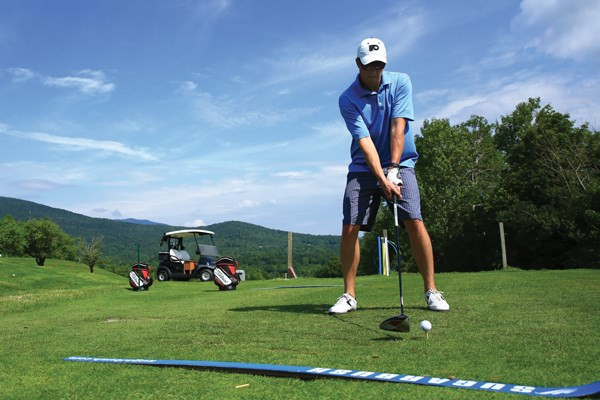A lesson with Roger King, Sugarbush’s new golf pro
As a kind of rite of initiation for Sugarbush’s new head golf professional, Roger King, I presented him with a golfing challenge equivalent to cracking the Enigma code: repair my seriously problematic driver swing. If he was up to solving that convoluted riddle, well . . . surely he was a genius, and a perfect choice for the job.
Not that I should have had any doubts. King, most recently the general manager of the Country Club of Barre, arrived at Sugarbush with a well-credentialed resumé. He was highly respected by his peers as president of the Vermont Professional Golf Association, and a guy who had already proven his chops.
After a year at Northeast Missouri State, the Illinois native embarked on the nomadic life of the fledgling teaching pro, spending winters in Florida and summers in New England, at courses from Massachusetts to Maine. It wasn’t just about teaching hackers like me; after he signed on at Barre fourteen years ago, he immersed himself in all aspects of the golf business—teaching, retail sales, membership management, corporate sales, and marketing. In between all those duties, he managed to fit in enough practice and competitive playing time to win the 2012 Vermont PGA Match Play Championship.
Perhaps most important, he is a people person, a great character asset in a job that, from the course to the practice range to the pro shop, is decidedly people oriented. “I love the customer interaction,” says King, who by his own account enjoys meeting new people and seeing them get better after taking lessons. Tackling my driving deficiencies, then, would be right in his wheelhouse. We had just met, and getting better was all but assured, given the technical nadir from which we would be starting.
At the heart of all good instruction is the bond nurtured by a teacher with his pupils. As King and I set up on the practice tee, he settled comfortably into connecting with me while analyzing my flaws and guiding me toward corrections. Without hoopla or grand philosophical pronouncements, he flowed smoothly into the process of tightening the loose technical nuts and bolts of my swing. There was none of the know-it-all self-assurance that some golf professionals let slip into their teaching methodology. He went about his business with a calm and unassuming demeanor.
He spoke with clarity and courtesy in noting immediately that my alignment—aimed too far right—was out of whack. Misalignment was coupled with a lack of lower-body engagement, and King talked about “building a ground floor” in my swing—activating the bigger, stronger muscles of my legs and hips. Over time, straighter, longer drives would be the payoff.
My efforts to incorporate King’s recommended changes were often comical, but he remained patient and encouraging as I flailed in attempting corrections, at one point even making a complete whiff at the ball. In tone, he managed to find a nice balance between professionalism and humor in critiquing my swing.
It was all extremely helpful—but did not, in King’s assessment, necessarily take full advantage of his expertise. A slender man, he is not a big hitter and has thus built his own competitive success around honing his play within 100 yards of the green. “I don’t care how good your putting and short game are,” he says; if you give him a little time to fine-tune all the short but delicate shots that are critical to lowering your score, “you’re going to get better.”
He also enjoys the cerebral part of the game, likening it to a chess match. Golf, he says, is about “having the discipline to play to your strengths”—to know when to be aggressive and when to be conservative, to be clearheaded about the risk-reward evaluation in choosing a shot. He likes conducting on-course clinics that focus less on swing technique—something you can tinker with on the practice range—than on decision making. When is it smart to go for the green with a long iron, and when does it make sense to lay up? When should you go for a lofted flop shot, and when should you go for a low-trajectory pitch? Given your own personal skill set, what chance do you have of executing any particular shot successfully? When should you risk a challenging shot, and when does a different, more manageable shot make sense?
Golf is a game, not just an athletic activity, and tactics and technique need to find a happy medium. But hitting long, straight drives sure helps, and King sure helped me. I went from the lesson to the first tee and striped my first drive high and straight, just left of the fairway center. But after three-putting the first green, I realized that there was still plenty of work to do. Next up: tapping into King’s short-game expertise.



